Note: This review does include a major spoiler (I talk briefly about the ending and how it relates to those of two other Schrader films), but it’s confined to the second half of a single paragraph and advance warning of its arrival is given.
John LeTour (Willem Dafoe) is a 40-something delivery man for New York-based drug-dealer Ann (Susan Sarandon), whose base of operations is an apartment she shares with her gay business partner Robert (David Clennon). But John doesn’t peddle his wares on street corners – if you want drugs from John, then you make a phone call and he’ll deliver them to your apartment or your fancy hotel room in a chauffeur-driven car. You’ll pay considerably more than street value, but you get personal service and you can rest easy in the knowledge that John will never rip you off or sell you bad shit. An ex-junkie himself who has been clean for two years, John makes only a basic living doing deliveries but is friends with Ann and Robert and appears to have no other direction in which to take his life. Currently foremost in his mind is that Ann has plans to quit the business and start a small cosmetics company, but an unexpected encounter with his former girlfriend Marianne (Dana Delany) is set to impact him in ways that he could not have predicted.
From the opening scene there are clear indicators that Light Sleeper is a Paul Schrader film, and by the finale there is irrefutable evidence in the shape of the themes and imagery from his earlier films that have been reshaped and repurposed here. The most visible connection is to Taxi Driver, which was written by Schrader and directed by his four-time collaborator Martin Scorsese. Like that film’s troubled lead character Travis before him, John keeps a diary, the narration of whose entries provides a small insight into his life and world view. He doesn’t write every day, just when the mood takes him, and once a journal is full he throws it away and starts a new one. I have a feeling I could spend a detailed paragraph on the subtextual implications of that act alone, and another on the link between his position as a backseat passenger and his status as a glorified errand boy. Later links to Taxi Driver include a diary entry that makes reference to a lifestyle change (the wording immediately rings a memory bell), a climactic confrontation that descends into violence, and an altogether calmer end-of-film coda. There are even conscious stylistic links in the close-up angles on John’s car as it moves through the New York streets that directly mimic shots in Scorsese’s film, small nods to the past in a classically shot work in which such stylistic tics are rare. If this makes it sound like Schrader is simply recycling elements from the film that really put him on the map, it’s worth noting that these connections were deliberately made. Light Sleeper was designed from the off to follow Taxi Driver and American Gigolo as the third film in what was then a trilogy of works about lonely men on the edges of society who observe the lives of others while having no real life of their own.
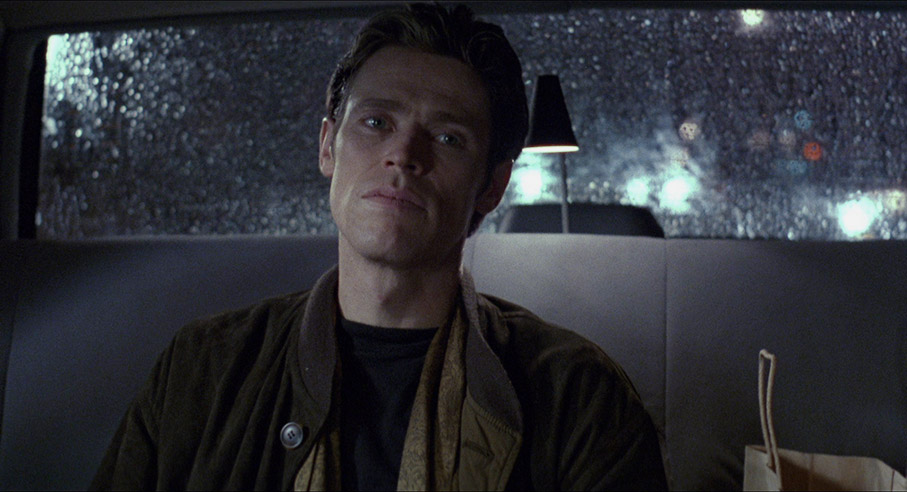
For its first two-thirds, Light Sleeper is first and foremost a character study, one that so quickly and effectively draws you in that it’s disarmingly easy to forget that John’s profession would usually cast him as a bad guy by default. The unforced naturalism of the lead performances really helps here, as does an approach to exposition that is subtle enough not to feel like exposition at all. That Robert is gay, for example, is not even mentioned until late in the film, but intimated when John walks into the apartment and kisses him gently on the head by way of greeting. My presumption that the two must be a couple was then dispelled by Ann and Robert's surprise that he doesn't own a television, something a partner would definitely be aware of. John’s loneliness, meanwhile, is suggested as much by his lingering gazes as his run-down and sparsely furnished apartment, a room in which he sleeps, takes phone calls and writes in his diary but that otherwise appears to be empty of fittings, decoration and personal touches. Like Travis, John is unconsciously searching for a way to escape his isolation and like him thinks he has found it in the form of a woman to whom he is deeply attracted and initially connects, but whom he ultimately prompts to turn on him by misjudging her and making an ultimately dumb move.
There’s almost a Mom-and-Pop feel to Ann and Robert’s business, with the drugs they buy from a supplier named Jealous (a small early role for a young Sam Rockwell) neatly bagged and labelled like home-made candies to be delivered in 19 gram portions, the maximum amount that an individual can legally carry and still claim it’s for personal use. From conversational snippets we learn that Ann has been dealing for a good few years and more than once has talked about going legit, but this time it really does seem to be for real. John’s initial uncertainly regarding what he will do when this happens is later intensified by a couple of hard knocks to his personal life into a sense of genuine fear and betrayal, one that finds vocal expression when an argument with Ann climaxes in his almost anguished cry of “You’re leaving me!”
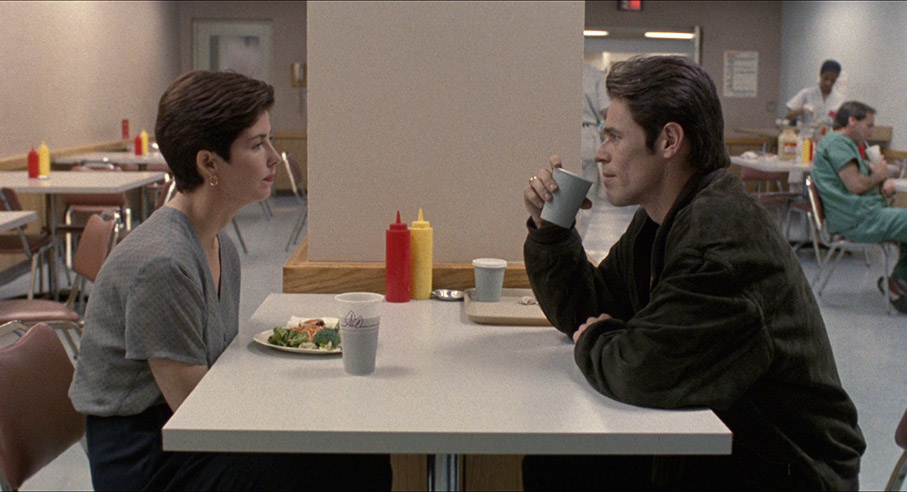
Willem Dafoe is perfect casting as John, his sunken cheeks and mournful gazes giving him a haunted look that lingers even under his convincingly friendly surface demeanour, and it’s a testament to an actor who can play sinister to sometimes terrifying effect (Bobby Peru anyone?) that he could come across as so lost and vulnerable here. This is really brought home when he realises he’s being watched by young plain clothes detective Bill Guidone (Robert Cicchini) and challenges him, only to be slammed against a laundromat window and forcefully intimidated in a way that quickly puts him on the back foot. That the scene jars as much as it does is down in part to the almost refined way that John conducts business with the wealthy professionals who are his clients, sitting politely and listening to them babble from the effects of cocaine and only getting rough with badly bombed-out regular Eddie (Paul Jabara) when he tries to prevent John from making a call that will ultimately help to save the man’s life. How often do you see a film in which a conscientious dealer is concerned about the welfare of his clients? Susan Sarandon is equally well cast as Ann, engagingly relaxed and friendly in John and Robert’s company but switching into no-nonsense business mode to ball John out when he neglects his job to be with Marianne. Later, when she and John walk into what John has anxiously predicted will be trouble, her angry response to attempted intimidation by two armed goons makes it clear that she’s not someone who is used to being messed with. A short while later, when gently persuaded by John to leave him in potential danger, instead of slipping away she immediately takes action to disrupt any plans that may have been made against him. In an equally important role, Dana Delany is also impressive as Marianne, from her initial reluctance to reconnect with a man she suspects from the off is still using and dealing to her anguished fury when he shows up uninvited at her mother’s funeral. When the two next see each other, it’s a jarring moment that proves genuinely and dramatically life-changing for them both.
Schrader himself has stated that he intended Light Sleeper as “a mid-life movie,” which intriguingly is how some critics viewed the 1999 Bringing Out the Dead. This spiritual successor to Taxi Driver was once again written by Schrader (from Joe Connelly’s novel) and directed by Martin Scorsese, but here the anger of the earlier film had metamorphosed into a sense of helpless despair. In retrospect, it can be seen as another entry in Schrader’s ‘lonely outsider’ cycle, one that would continue with Schrader’s own The Walker and his more recent First Reformed. It also shares (spoilers ahead – skip to the next paragraph to avoid or click here) with American Gigolo and Light Sleeper a finale in which the central character finds a degree of solace and hope in the presence a woman with whom he may have a more stable and fulfilling future. What intrigues me most about these three endings is that the physical barrier that divides the two characters at the end of the first film has been lowered enough here to allow for physical contact and is completely removed by the time we get to Bringing Out the Dead.
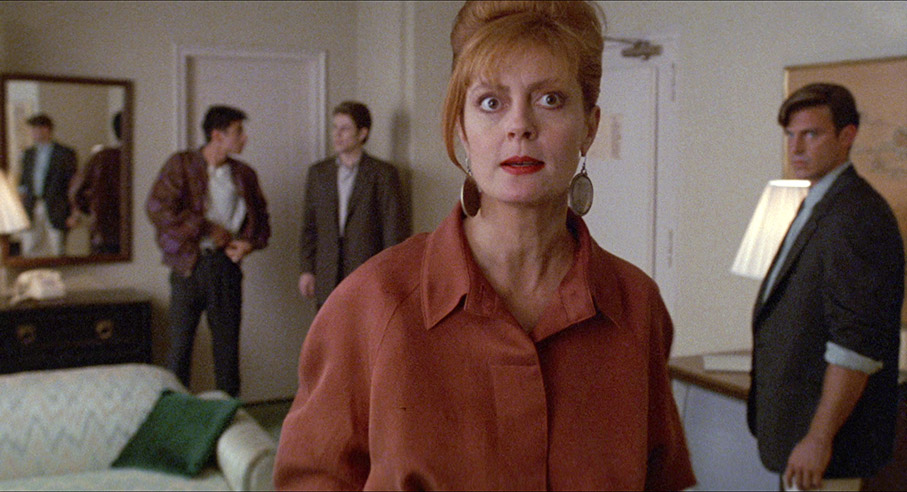
In its way, Light Sleeper is a quintessential Paul Schrader film, one that too often gets overlooked in discussion of his more confrontational or challenging works. While it does share plot elements with some of his other films, this seems to be a conscious decision designed to link them to each other and has allowed him over time to explore a range of takes on the same central character. It takes the notion that we are shaped as much by our environment as our past experiences, and ponders on how differently we might respond to what we see around us as an angry insomniac Vietnam veteran, an image-conscious gigolo, a directionless ex-addict or an overworked and sleep-deprived paramedic. The tonal shift from Taxi Driver and American Gigolo is announced in the opening frames, with Bernard Herrmann’s unsettling mix of foreboding bass notes and dreamy jazz from the first film and the driving beat of Blondie’s Call Me from the second replaced here by the more melancholic strains of Michael Been’s The World’s on Fire.
Once the film concludes you might find a couple of holes to pick in some of the recycled elements – Schrader himself regrets not coming up with a more original way of bringing things to a head than he does here – but for me, at least when watching the film rather than reflecting on it, there’s a strange inevitability to where the story eventually heads, as if it’s being pulled there by forces beyond the filmmaker’s control. It may not have the dazzling storytelling complexity of the brilliant Mishima: A Life in Four Chapters, the single-mindedness and disturbing rage of Taxi Driver or the tight focus of the recent First Reformed, but Light Sleeper is still, in its captivatingly low-key and unshowy way, one of Schrader’s most accomplished, arresting, richly textured and poetic works, and one that I found hugely rewarding to revisit.
The 1.85:1 1080p transfer on Indicator’s Blu-ray, which we can assume from the front-end logo was supplied by StudioCanal, is a typically strong one, and given how much of this film takes place at night or in darkened apartments, night clubs and bars, it needs to be. It doesn’t disappoint on any score. Detail is clear and well defined, and remains so when the image darkens without a weakening of the contrast or a softening of black levels. Colours are sometimes deliberately kept muted through savvy costume and production design but are lively when they should be (neon lights and cinematographer Edward Lachman’s occasional use of coloured gels are standouts here), and while sunny daytime exteriors are rare, when they do appear the image is close to pristine in all respects. The picture is clean of dust and damage and a fine film grain is visible.
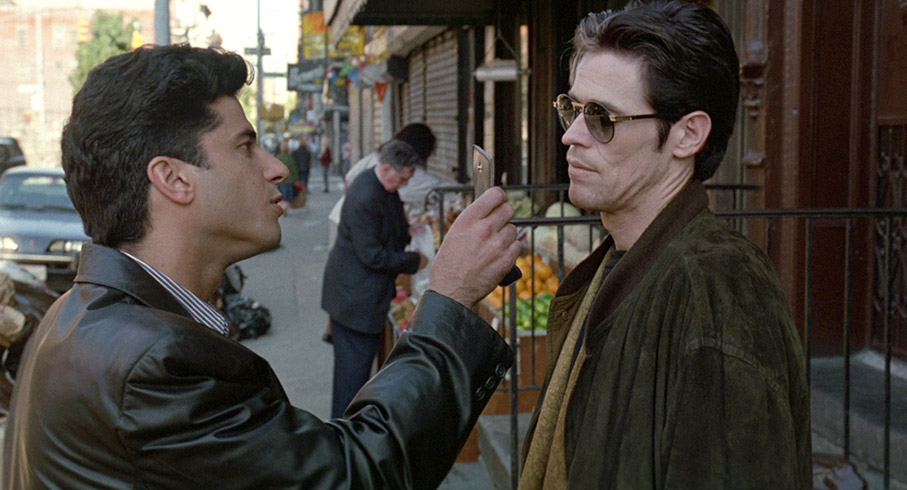
The Linear PCM 1.0 mono soundtrack is in excellent shape, having a far greater dynamic range and fidelity than you might expect from a mono track, something particularly evident in the clarity and depth of Michael Been’s music and songs. Dialogue is always clear, despite the sometimes quiet and conversational manner in which it is delivered, and there are no signs of wear or damage.
Optional English subtitles for the deaf and hearing impaired are available.
Audio Commentary with Paul Schrader
This commentary by writer-director Paul Schrader was originally recorded for a 2002 Lionsgate DVD release, and heading up this special feature is a caption warning that the original mix of that track was mistimed, with the result that some of Schrader’s comments are a few seconds out of sync with the picture (quite a few in one case), and without access to the original recordings this couldn’t be corrected. Frankly, I’d live with it, so useful a companion to the film does it prove to be, though if you listen to this first, be ready to hear some of what Schrader says repeated in some of the other special features. Foremost on this front is the story of how the idea for the film came to him in a dream, one in which he was visited by the real-life dealer on whom John LeTour was based and whom Dafoe hung out with to research his character. The casting of the leads and some of the supporting roles is covered, and there’s an interesting story about how he ended up working with Michael Been after his plan to use Bob Dylan songs fell through, though not for the expected reasons. He states up front that he sees LaTour as a progression of a character he previously wrote about in Taxi Driver and American Gigolo, the various connections to which he is happy to point out, and mentions the importance of small touches in film, however time-consuming they may turn out to be. He reveals that some of LeTour’s diary entries were taken from those kept by the real dealer on whom he was based, and notes that “there are far more good actors than there are good movies, good scenes or good dialogue.” He also states that Light Sleeper may be his favourite of his own films, or certainly the one that affects him the strongest. There’s loads more here. Essential listening.
Selected Scenes Commentary with Willem Dafoe and Susan Sarandon (17:46)
Willem Dafoe and Susan Sarandon, recorded separately and edited together in the manner of classic Criterion commentaries, talk about their roles in the film, and in Dafoe’s case the preparation for it, which involved accompanying the white collar drug dealer his character was based on as he did his rounds. Sarandon confirms that her work on the film was compressed into two weeks (this was, Schrader reveals in his commentary, done to fit in with her work on other projects) and that Schrader was not what she was expecting and actually rather fun. Who’d have guessed?
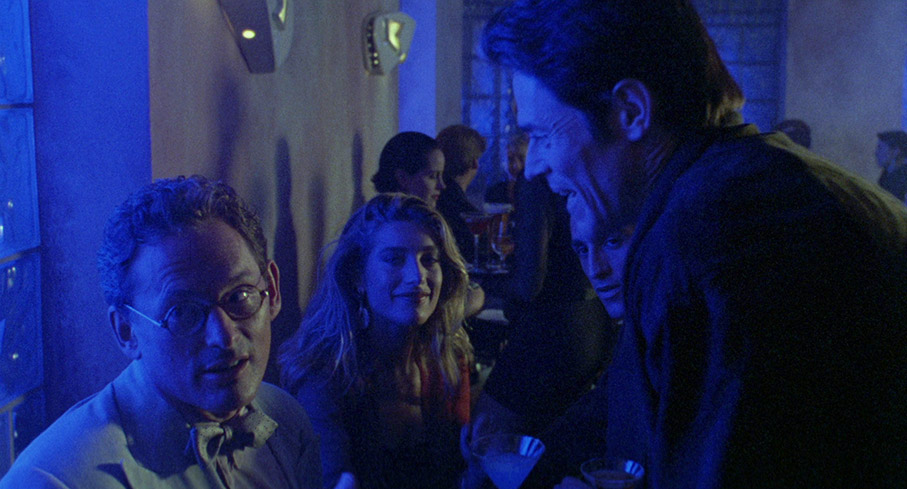
The Guardian Interview with Willem Dafoe (65:35)
Playing as a second commentary track, this audio recording of an onstage interview with Dafoe was originally made for archival purposes only and not intended for wider release, so has the by-now standard warning up front about audio issues. To be honest, the only problem I had was making out the audience questions, which despite valiant attempts to boost the sound levels are still too quiet and indistinct to break through my tinnitus, but Defoe’s response tends to clarify things. He reveals why he got kicked out of high school, talks about getting into experimental theatre and his early film work in villainous roles, and touches on his boot camp training for Platoon, the false teeth that helped him become Bobby Peru in Wild at Heart, and the challenge of playing Jesus in The Last Temptation of Christ. He talks again about following the dealer on which his character in Light Sleeper was based as he conducted his business (and recalls occasionally being recognised while doing so), explains his reasons for doing the lowly regarded Body of Evidence and Speed 2, and reveals that he actively pursued a guest role in The Simpsons. Asked if there was any role he wanted that he didn’t get, he thinks for a few seconds and then cites H.I. McDunnough in the Coen brothers’ Raising Arizona, a part that ultimately went to Nicolas Cage.
Paul Schrader: The Midlife Movie (17:43)
A newly shot interview with Schrader in which he talks about the film and covers similar ground as the commentary when it comes to the film’s genesis, music and cinematography, but still has its share of unique material. Here he talks about the importance of trying ideas in rehearsal rather than on set where you have a whole crew waiting, reveals that he couldn’t get the film financed without an action scene, and nicely describes it as having a good shelf life. He reaffirms that this is one of his personal favourites, but adds that he now likes First Reformed more.
The BAM Interview with Ed Lachlan and Paul Schrader (31:02)
This onstage interview with Schrader and cinematographer Ed Lachlan was held after screening of Light Sleeper, during a retrospective of Lachman’s work at the Brooklyn Academy of Music, New York, in May 2008. The original footage has been lost so this was taken from a low-resolution copy, which is never a problem when the content is worthwhile, as it definitely is here. If you’re approaching the special features in the order they appear on the disc menu (which is how I tend to list them) then you’ll already be familiar with some of Schrader’s responses to the questions asked here, including how the idea for the film came to him in a dream and how he’d originally structured the script around Bob Dylan songs and why he was unable to use them. There are still responses that are specific to this extra and Lachman intermittently gets a word in to talk about the use of coloured gels in the sex scene and the fact that no camera setup was used more than once, while both men talk about shooting on location in New York.
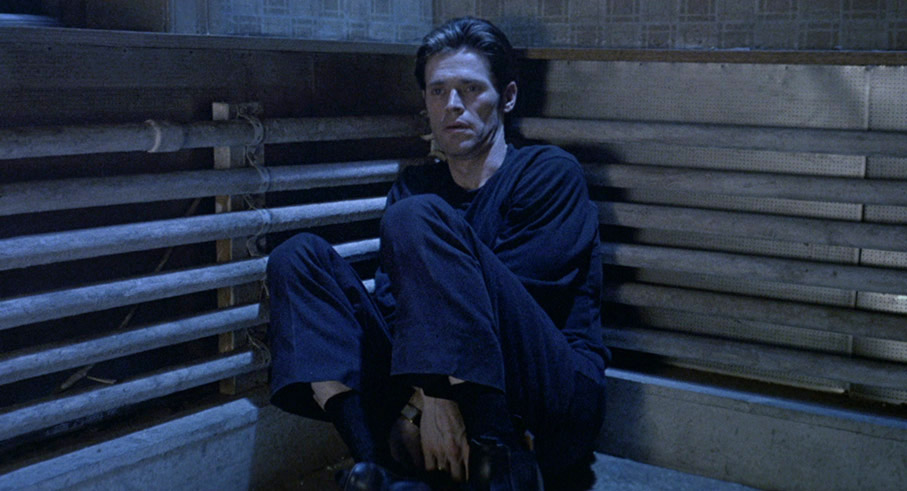
Dear Paul Schrader, Thank You for Light Sleeper (10:37)
Filmmaker and critic Mark Cousins pens an audio letter of thanks to Paul Schrader for the Light Sleeper, which is visually accompanied by a wobbly, sub-Kenneth Anger/Derek Jarman wander over objects in one room of his house/apartment before settling down to watch a thunderstorm breaking outside. Likely to annoy as many as it intrigues, but Cousins does make a couple of really interesting observations about the film, one of which hadn’t occurred to me at all and gave me an alternate reading of the film’s second half.
Theatrical Trailer (1:56)
A bucket of spoilers for the climactic scene in a trailer that makes the link early to Taxi Driver and American Gigolo and should be avoided before seeing the film for the first time.
Image Gallery
41 screens of grainy promotional stills (some of which may count as spoilers), scans from pages of the production notes and posters.
Also included is a limited edition exclusive 36-page Booklet with a new essay by Christina Newland, an archival on-set report for Sight and Sound by Kevin Jackson, an overview of contemporary critical responses, and film credits, but this was not available for review.
I first saw Light Sleeper on video a couple of years after its cinema release, but for reasons I can’t easily explain (that may or may not be alcohol-related) I couldn’t remember much about it, but since revisiting it I haven’t been able to get it out of my head. It’s every inch a Paul Schrader film in everything that’s good about that statement, from the precision-controlled direction and pitch-perfect performances to its thoughtful re-examination of favourite themes and its lonely outsider of a central character. It’s a compelling work from a hugely talented writer-director and it looks and sounds great on Indicator’s very fine Blu-ray. Warmly recommended.
|